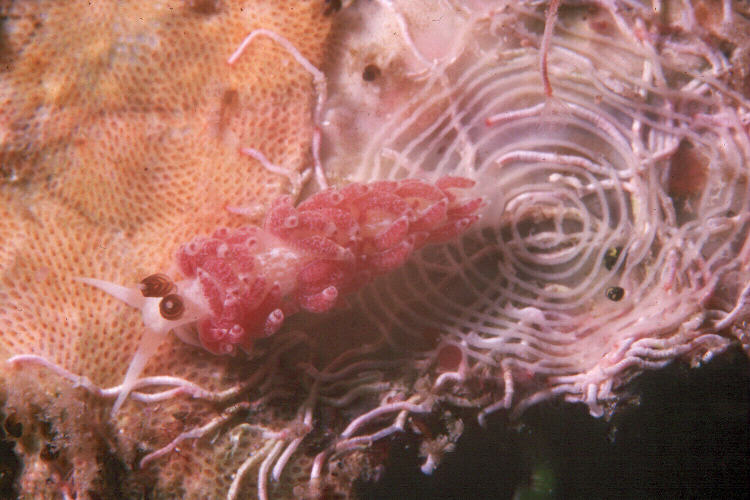 |
Favorinus elenalexiarum
Courtesy of Dr. Hans BertschPhoto taken at south end of Isla Cerralvo, June 1985
Favorinus elenalexiarum García and Troncoso, 2001
Almost 2 years ago, Terry Gosliner and I received a manuscript in the
mail from José Leal, the editor of The Nautilus. He was asking us to
comment on its suitability for publication; this is called peer review,
and is a standard procedure prior to the acceptance of all articles in
"refereed" journals.
Well were we certainly surprised! Our Spanish friends Francisco García and Jesús Troncoso were going to name a species of nudibranch that we had known about for over 15 years. All their material had been collected intertidally only a few years previously, in February 1997, at Isla Coiba, Panamá. Whoa, we were going to be scooped. But then, we had really sat on our new species for an awfully long period of time....
Terry and I talked among ourselves, and decided that we would offer our data to the authors; we also convinced the editor that their article would be much more complete with our data. This included anatomical, distributional, and bathymetric information.
García and Troncoso described the external anatomy fairly completely: " The body is elongate. The largest specimen examined was 15 mm long in distended state. The body has up to 7 ceratal groups on each side. The three anterior groups are horse-shoe shaped, while the rest are oblique rows slightly curved at their distal end. The number of cerata in the clusters was 16, 12, 11, 5, 4, 2, and 2 in a specimen 14.5 mm length. The cerata have a smooth surface. The genital papilla lies on the right side at the level of the first ceratal group. The anus lies on the same side at the level of the second ceratal group. The rhinophores are blunt-tipped and have three large overlapping flanges with the upper margins free in the manner of three cups. On the anterior and posterior surface of the rhinophores there is a thin crest joining the flanges. The oral tentacles are long and cylindrical and the propodial tentacles are long and possess a ventral, longitudinal groove. The foot is relatively broad and the tail is long and pointed.
"The background color is translucent white. " On the head and back there are fine opaque white dots, which can come together as spots of different sizes, except at the base of the rhinopores and base of the oral tentacles. The oral tentacles are translucent white at the base and opaque white along their upper middle. The rhinophores are dark brown except for their base, which is translucent white and their apexes, which are opaque white. The cerata have white spots distributed on their surface; at the level of the cnidosacs the spots join as an irregular ring around the cerata. Internally to the cerata, the extensions of the digestive gland are pinkish. All the digestive branches of a cluster of cerata are joined at the base of the cluster. The digestive branches are pink in color. The foot is translucent white. " To me the most obvious color patterns are the chocolate brown of the rhinophores, and the pink of the cerata; above the white subapical band is a splash " paint drop " marking of pink.
The pictures I have attached here are the first published full color photographs of this species. García and Troncoso only published a line drawing of the animal.
The species is named in honor of the scientists’ youngest daughters: Elena García and Alexia Troncoso. The text misprints the species’ name several times as: elenaleixa. The authors erroneously named the species with an - -ae termination; this should be corrected to - - arum (as I use here), which is the proper Latin suffix for species named in honor of more than one female individual.
This species is known to occur from Bahía de los Ángeles (in the northern Gulf of California, Mexico) to the Islas Galápagos, Ecuador. Although in the Distribution section of their article they cite the Pacific coast of Panamá as the southernmost limit, in the Map and Other Material Examined, they cite the Galapagan localities. To my knowledge, the first collection of this species was subtidally in February 1972, by Antonio J. Ferreira, at Guanacaste, Costa Rica.
Little is known about the biology of this species of Favorinus. Presumably it eats the eggs of other nudibranchs.
In June 1985 I found the egg mass of Favorinus elenalexiarum (please also see the opening photograph) under a rock in 5 m of water at the southern end of Isla Cerralvo, Baja California Sur.
Scanning electron micrographs of a portion of the radular ribbon (lateral views) and
an individual tooth were published in the original description. These
scanning electron micrographs were provided the authors courtesy of Terry
Gosliner.
Reference
García, Francisco J., and Jesús S. Troncoso. 2001. Favorinus elenalexiae
[sic], a new species (Opisthobranchia: Aeolidiidae) from the eastern
Pacific Ocean. The Nautilus 115 (2): 55-61.
Imperial Beach, Calif
Sept. 2001
Photo Courtesy of Terry Crawford, Univ. Brit. Columbia

| Sandra Millen and Hans Bertsch at a Mexican Military Checkpoint (near San Ignacio, Baja California Sur (July 2001). They were set free after a thorough search revealed no contraband nudibranchs. Send Hans email at hansmarvida@aol.com |
